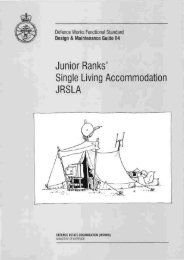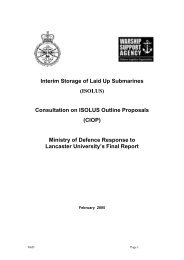Specification 49 Stone Mastic Asphalt for Airfields - Ministry of Defence
Specification 49 Stone Mastic Asphalt for Airfields - Ministry of Defence
Specification 49 Stone Mastic Asphalt for Airfields - Ministry of Defence
Create successful ePaper yourself
Turn your PDF publications into a flip-book with our unique Google optimized e-Paper software.
<strong>Specification</strong> <strong>49</strong> <strong>Stone</strong> <strong>Mastic</strong> <strong>Asphalt</strong> <strong>for</strong> <strong>Airfields</strong> 7 Trials<br />
7.2.9 After completion <strong>of</strong> all preliminary trials, the<br />
edges <strong>of</strong> the lanes shall be feathered <strong>of</strong>f in asphalt<br />
surfacing as necessary <strong>for</strong> the requirements <strong>of</strong><br />
vehicular traffic to the approval <strong>of</strong> the Project<br />
Manager.<br />
7.3 FINAL TRIAL AREAS<br />
7.3.1 Following completion <strong>of</strong> the preliminary<br />
trials described in Clause 7.2, a trial area <strong>of</strong><br />
surfacing, not less than 60 m or more than 300 m<br />
long by two rips wide, shall be laid <strong>for</strong> each layer<br />
thickness <strong>for</strong> each mixture. Duplicate areas shall<br />
be laid <strong>for</strong> each additional spreader and <strong>for</strong> each<br />
thickness on which each particular spreading unit<br />
will be working. The trial areas shall be laid along<br />
the outside edges <strong>of</strong> the pavements in positions<br />
approved by the Project Manager.<br />
7.3.2 Each trial area shall contain at least one<br />
60 m continuous length <strong>of</strong> longitudinal joint and at<br />
least 4.5 m <strong>of</strong> transverse joint.<br />
7.3.3 The Contractor shall submit the results <strong>of</strong><br />
an analysis, carried out in accordance with<br />
BS EN 12697-1 and BS EN 12697-2, to the Project<br />
Manager <strong>for</strong> each lorry load <strong>of</strong> the trial mix laid to<br />
demonstrate compliance with the requirements <strong>of</strong><br />
Clauses 4.2, 4.3, 4.4 and 4.10.<br />
7.3.4 When the trial surfacing has cooled to<br />
ambient temperature, six 150 mm diameter cores<br />
shall be cut according to BS EN 12697-27 using a<br />
coring machine that has been approved by the<br />
Project Manager. The cores shall be evenly spaced<br />
along the length <strong>of</strong> the trial surfacing with at least<br />
2 cores being taken adjacent to longitudinal lane<br />
joints at a distance not exceeding 50 mm or nearer<br />
than 25 mm from joint edges. The initial and final<br />
cores shall not be taken within 7 m <strong>of</strong> the ends <strong>of</strong><br />
the length <strong>of</strong> surfacing. From these cores:<br />
• the thickness shall be determined according to<br />
BS EN 12697-36;<br />
• the bulk density shall be determined according to<br />
BS EN 12697-6, Procedure A;<br />
• the maximum density shall be determined<br />
according to BS EN 12697-5, Procedure A; and<br />
• the air voids content shall be determined<br />
according to BS EN 12697-8.<br />
The average air voids content shall not exceed<br />
5.5 % nor be less than 2.0 % and an individual<br />
result shall not exceed 6.5 %.<br />
(NOTE. For very small works and at the discretion <strong>of</strong> the<br />
Project Manager, the maximum density and air voids<br />
content may be omitted.)<br />
7.3.5 If the trial area is approved, the Job<br />
Minimum Density shall be defined as 93.5 % <strong>of</strong> the<br />
mean maximum density determined in accordance<br />
with Sub-Clause 7.3.4.<br />
7.3.6 The Contractor shall demonstrate the<br />
effectiveness <strong>of</strong> his compaction method as defined<br />
by the requirements <strong>of</strong> sub-Clause 7.3.4. The<br />
standard <strong>of</strong> finish, including that at joints, shall<br />
comply with the requirements <strong>of</strong> this <strong>Specification</strong><br />
and be acceptable to the Project Manager as the<br />
standard to be achieved in future laying. The<br />
surface finish shall have no laying defects, such as<br />
dragging or surface blemishes.<br />
7.3.7 When the Project Manager has approved<br />
the trial area, the Contractor shall confirm in writing<br />
the weights, proportions and overall grading <strong>of</strong> the<br />
mixture used in the trial to the Project Manager.<br />
Thereafter, they shall be used as targets <strong>for</strong> future<br />
plant mixing with due regard <strong>for</strong> the tolerances in<br />
this <strong>Specification</strong>.<br />
7.3.8 The approved length <strong>of</strong> the trial area shall<br />
be permanently marked ‘Approved’ and dated and<br />
the approved longitudinal and transverse joints are<br />
to be permanently defined.<br />
7.3.9 If the trial area is approved, it shall be<br />
allowed to remain. Otherwise, the full length shall<br />
be removed as specified in Clause 6.1 and replaced<br />
with new material to the required standard at the<br />
Contractor’s expense.<br />
7.3.10 Until approval has been given, the general<br />
laying <strong>of</strong> SMA surfacing required by the Contract<br />
will not be permitted to start.<br />
7.3.11 The standard <strong>of</strong> workmanship and finish <strong>of</strong><br />
all surfacing included in the Contract shall be equal<br />
to that <strong>of</strong> the ‘Approved’ areas and shall not be<br />
changed afterwards without the specific approval <strong>of</strong><br />
the Project Manager.<br />
7.3.12 If <strong>for</strong> any reason the quality, grading or<br />
supply source <strong>of</strong> any <strong>of</strong> the aggregates is changed,<br />
a new mixture shall be designed and approved on<br />
the basis <strong>of</strong> further trial areas.<br />
7.3.13 Based on the trials, the rollers and rolling<br />
method to be adopted <strong>for</strong> each course shall be<br />
agreed with and approved by the Project Manager.<br />
7.3.14 No change shall be made afterwards in the<br />
mixing and spreading plant or rolling methods<br />
without the approval <strong>of</strong> the Project Manager, and<br />
then only after new trials have been carried out and<br />
approved.<br />
July 2008 25









